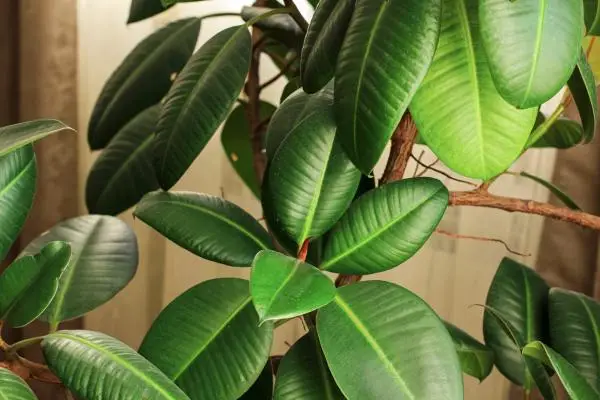The ficus elastica, also commonly called ficus robusta, is one of the most common large indoor plants that can be found. Popular for its large, glossy, dark green leaves, it is a very easy-care, fast-growing species when grown under the right conditions. What not so many people know is that the ficus elastica is actually a large tree from tropical Asia and that in similar climates and with enough time, it can reach really impressive sizes.
If you want to learn more about the care of the ficus elastica, keep reading this article where you will see a practical and complete guide.
Characteristics of the ficus elastica
This tree native to the rainforests of India is a perennial species, well known for the striking green of its leathery textured leaves. In Mediterranean climates, it tends to grow up to 10 or 15 meters in height, although in its original habitat it exceeds 30. Its trunk is grayish in color and smooth in texture when the tree is young, wrinkling and cracking as it ages. Its roots are wide-ranging and extensive, although shallow.
It is, despite this, a very popular species when growing as a houseplant, logically reaching much smaller sizes when grown in pots.
Location and light for the ficus elastica
This plant requires an environment that is as bright as possible, and the ficus elastica loves light. It even tolerates direct exposure to the sun without problems for a few hours a day, as long as it is not in the midday hours and in very hot climates, where the sun is especially intense.
This point is the most important since if you plan to grow your ficus elastica indoors and you do not have a bright place for it, it will end up losing its leaves, suffering, and wilting. If you can’t dedicate a space as bright as you should and have to settle for a location by the window, turning the pot once a week will help all the leaves receive enough sunlight and regularize their growth and development.

Climate for the ficus elastica
The ficus robusta or ficus elastica grows very well in both tropical and Mediterranean climates. The important thing here is really not to expose it to frost, as it does not support temperatures below 0 ºC, and it does not even tolerate well those that approach this point unless it is very acclimatized.
With high temperatures, there is no problem, as long as it is not exposed to sudden changes in temperature. If you have it in a pot, and there is a large difference in temperature between the inside and outside of the house, do not move it suddenly from one to the other or the leaves will fall in response to the sudden change.
Irrigation for the ficus elastica
The other great key point in the care of this ficus is watering. In this case, the most important thing is not to overdo it: always try not to water until the substrate has almost completely dried since the last time. Despite being a tropical plant, these saplings cannot withstand excess water and too abundant watering is a guarantee that problems with fungi will end up.
The first symptom of an excess of watering in the ficus is that the lower leaves seem to turn yellow and fall or are weakened. If you see this, immediately reduce your risks. It is also especially important for this to have a container with good drainage holes .
Being tropical, a little humidity is also good for it, for this you can spray water around it and take advantage of it to clean its leaves. Never do it when the sun is out, wait for the night.

Soil and substrate for the ficus elastica
This plant, which stands out for its rusticity while maintaining its necessary conditions of low humidity and good light, is not demanding in terms of the substrate in which it grows. In this sense, the most important thing will be to prepare a light one with good drainage , for which the universal peat mixed with coconut fiber or with a good addition of vermiculite and perlite will be enough. If you want, yes, you can give it a good contribution of worm humus or compost, which the plant will always appreciate.
Other tips for caring for a ficus elastica
To finish we give you some more tips to take good care of this tree that can be indoors and outdoors.
- If your ficus branches very little, you can always clamp it and stimulate the appearance of new branches , activating the buds close to the cutting point. Remember to always use well-sharpened and sterilized tools.
- It is also advisable to use stakes if the plant seems to have problems keeping its stem upright due to the heavy weight of its leaves, which is very likely to happen.
- It is recommended to clean the sheets with a soft cloth moistened with warm water. The accumulation of dust and dirt on them can make it difficult for both the absorption of light and proper respiration by the plant.
- If your ficus seems to lose its leaves in a large quantity shortly after getting it or when it is relocated, it is probably due to too abrupt acclimatization : be patient and give it time.


